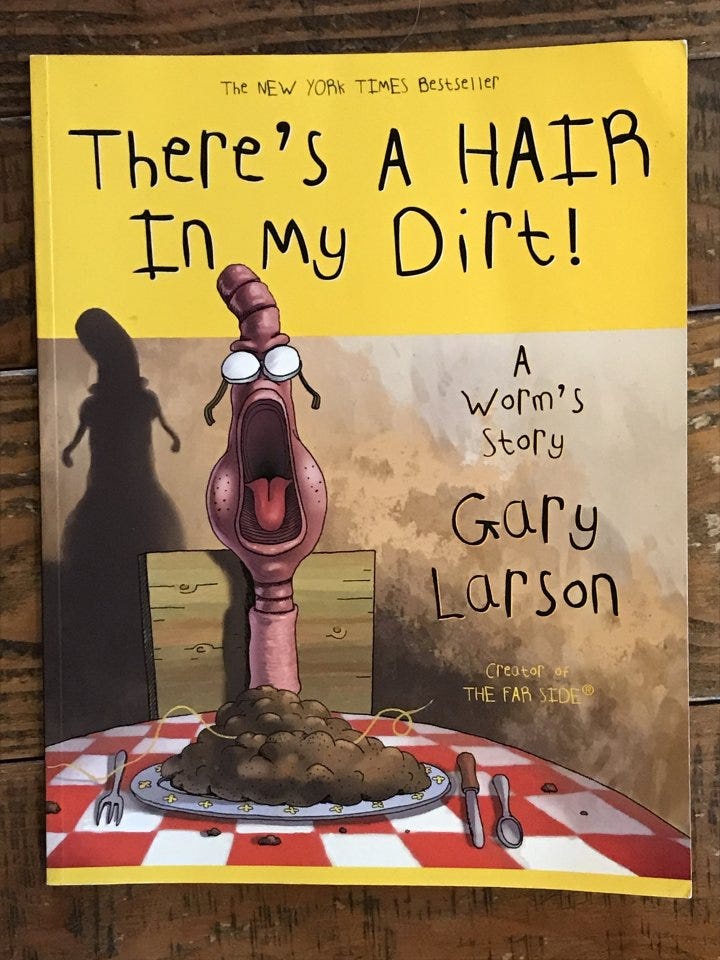Book Review—There’s A Hair In My Dirt! A Worm’s Story. By Gary Larson
Pathological Illusion—People are Special
My birthday just passed. I’m aging, cynical and often cranky and I don’t really want (or need) gifts; shouldn’t we be trying to cut down on stuff? But a good friend took a chance and brought me a used copy of Gary Larson’s 1998 book, There’s A Hair In My Dirt! A Worm’s Story. The book arrived by bicycle in a covert brown paper bag with no ribbons and bows—just the way I like it. How intriguing. I guffawed as I read through it—this is controversial stuff!—how can Larson get away with writing this in today’s touchy-feely and woke atmosphere when we all have to pretend humanity is so special and above Nature’s laws? How did this realistic delivery of Nature reach the New York Times Best Seller list with its truthful punch that I keep hearing adults aren’t ready to hear? I guess famous people can take chances and clearly, some people can handle, and may even enjoy, the truth. And wow the final scene, that’s one life lesson for Harriet, the dear maiden.
The story opens with a young worm boy, objecting with horror to his dirt dinner fouled by a hair. “I HATE BEING A WORM”, he howls as he launches into a full on pity party. But it’s gross, right?!! It’s a big fucking hair in his dinner. The reader can clearly see it and the tension builds as Mother and Father Worm inspect the plate. Indeed, it’s a hair!! YUK. No need to panic though, Father Worm in typical parenting style, launches into a lengthy, eye rolling moral lecture that is the last thing any kid, human or annelid, wants to hear. Mother Worm plays the classic role of propping up big Father Worm’s authority—hmm, that rubs me a little bit the wrong way—but the overarching story overshadows this problematic aspect. Worm Boy is encouraged to hang in for the happy ending.
So, Father Worm, with his “primitive pharynx” Once-Upon-a-Times us to a cabin in the forest, home to the maiden, Harriet. Although she lives amongst Nature in a forest surrounded by animals she still feels a need to dot the curtilage with pink flamingo yard-monstrosities. That’s a sign right there. With arms flung in glee, she launches out in inappropriate foot wear and a pink dress to forest bathe. You go girl...it’s all about you and your feelings. Her arms remain deliciously awkward throughout the story and it turns out she can climb a tree in party shoes (I was impressed by this).
And how does Harriet connect with Nature? She gushingly feeds invasive Gray Squirrels that are busy bumping native Red Squirrels out—maybe she’d like to take on some introduced Canada Geese and bunny rabbits too! Then she frolics and marvels at a variety of animals making up things about Nature as she goes along. She pitches animals into habitats where they can’t survive in order to “save” them and so many things she observes are interpreted as pure magic. It’s a dramatic life for Harriet, swooning one moment over the sheer cuteness of fawns, then demonizing predators the next.
Truth is, as I read this book I wanted to make little paper cut-out outfits to put on Harriet to change her into other equally dubious characters. Perhaps a sustainability consultant outfit armed with sticky notes and a PowerPoint filled with “win-win” catch phrases promoting the green economy—we can grow forever on a finite planet, we just have to switch to renewable energy. Perhaps a vehement placard-carrying protester outfit, launching from one cause to the next—all symptoms with no mention of the root cause: economic growth. Perhaps a corporate green-washer outfit, pushing yet another new save the environment techno gadget we don’t need with planned obsolescence built it so the damn thing busts when you’re taking it out of the box; oh, and the item isn’t repairable. The possibilities are ... but, I digress.
If you like Larson, you’ll like this book. Read it and laugh at the predicament we’re in. Enjoy the macabre vignettes at the edges of each illustration. It’s classic Larson. The delightfully elegant ending illustrates that humans aren’t special in any way that will help us survive ourselves. But don’t take it just from me—I’m an unknown cranky old tranny. Perhaps a review from a famous person, like E. O. Wilson will convince you; he’s written the foreword to Larson’s book and he is pretty famous. He’s one of the leading scientists in the world, recognized as a foremost naturalist; he’s now the Chairman of the Half-Earth Council.
Wilson writes that Homo sapiens is no exception to the iron rules of Nature. “The point is that we, too, are organisms. We are subject to the same physical laws, still tied to the planet, totally enmeshed in food webs, energy flows, nutrient cycles, predator-prey cycles, territorial imperatives, and even slavery of other species, such as cows and dogs.”
As I often say about people, yeah we’re all special...in a non-special way.
Notes:
Larson. G. Foreword by E. O. Wilson. 1998. There’s A Hair in My Dirt! Harper Perennial. New York.
https://www.half-earthproject.org/discover-half-earth/#wilson accessed 4 December 2021
Half-Earth: Our Planet's Fight for Life is a 2016 book by the biologist E. O. Wilson, in which the author proposes that half of the Earth's surface should be designated a human-free natural reserve to preserve biodiversity. Wilson noted that the term "Half-Earth" was coined for this concept by Tony Hiss in his Smithsonian article "Can the World Really Set Aside Half the Planet for Wildlife?"
https://en.wikipedia.org/wiki/Half-Earth accessed 4 December 2021




